Physical Address
304 North Cardinal St.
Dorchester Center, MA 02124
Physical Address
304 North Cardinal St.
Dorchester Center, MA 02124
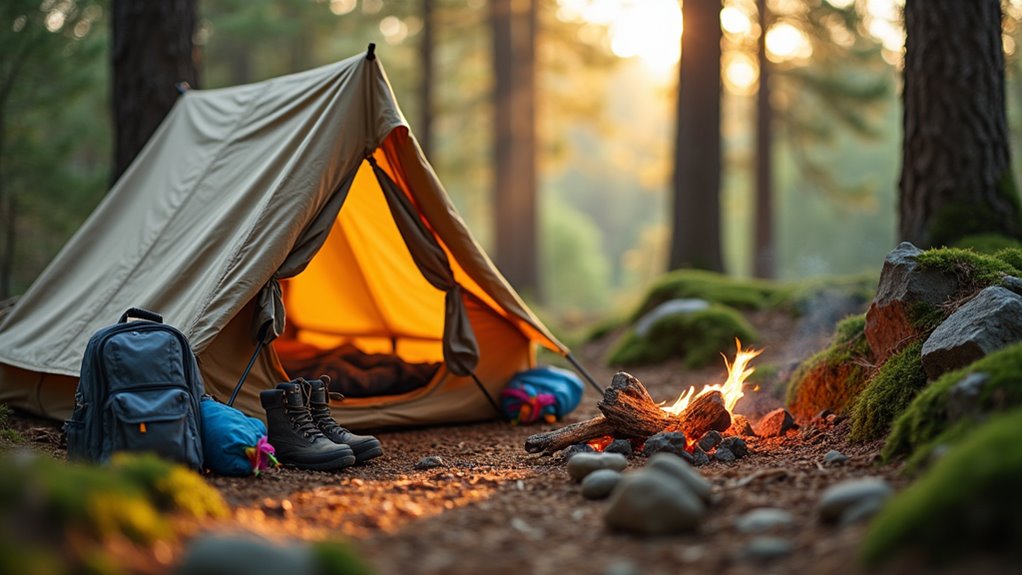
Smart camping parents know these 12 essential secrets that transform chaotic family trips into unforgettable adventures your kids will treasure forever.
You’ve probably watched other families return from camping trips with glowing stories and wondered if you could pull off the same adventure with your own kids. The truth is, camping with children isn’t just about throwing gear in the car and hoping for the best. There’s a specific approach that separates magical family memories from complete disasters, and it starts with understanding what experienced camping parents wish they’d known before their first trip.
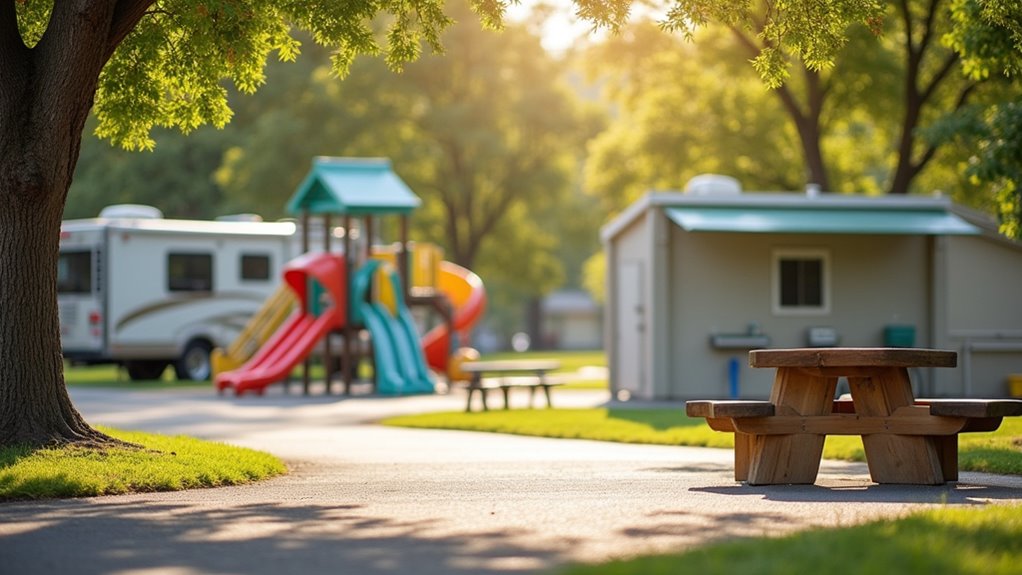
When you’re planning your family’s first camping adventure, selecting the right campsite can make or break the entire experience. Look for established campgrounds with amenities like restrooms, potable water, and designated fire pits rather than primitive sites. These facilities reduce stress and provide safety nets when you’re managing children outdoors.
Consider your kids’ ages when choosing accommodations. Toddlers need secure boundaries, so fenced campsites work well. Older children can handle tent camping, but younger ones often sleep better in RVs or cabins with familiar comforts.
Research campgrounds with family-friendly features like playgrounds, swimming areas, or nature programs. Check proximity to medical facilities and cell service coverage. Read reviews from other families to gauge noise levels and safety.
Popular family campgrounds book quickly, so reserve well in advance. Plus, since children are particularly attractive to mosquitoes, choose campsites with good airflow and avoid areas near stagnant water where these pests breed, as proper mosquito control strategies become essential for keeping your family comfortable during outdoor adventures.
Since children are naturally curious and prone to minor accidents, you’ll need a well-stocked first aid kit that goes beyond basic bandages. Include antiseptic wipes, gauze pads, medical tape, children’s pain relievers, antihistamine for allergic reactions, and thermometer.
Pack tweezers for splinter removal and instant cold packs for bumps and bruises.
Add safety gear like flashlights with extra batteries, whistles for each child, and glow sticks for nighttime visibility. Bring insect repellent and sunscreen specifically formulated for kids.
Don’t forget any prescription medications your children take regularly, plus a few extra days’ worth.
Create a laminated card with emergency contact numbers, including local rangers and nearest hospital. Keep everything organized in a waterproof container that’s easily accessible.
Consider expanding your safety preparations by learning wilderness survival kit assembly techniques that can help you handle unexpected situations when camping with children.
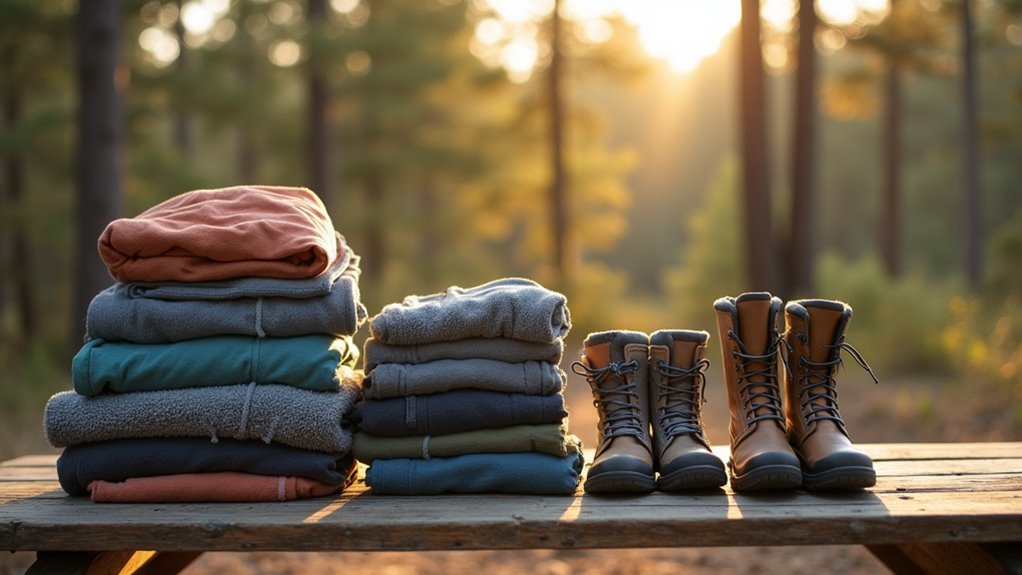
After securing your family’s safety needs, turn your attention to clothing that’ll keep everyone comfortable regardless of what Mother Nature throws your way. Weather changes quickly outdoors, and what starts as a sunny morning can turn into a chilly, wet afternoon.
Pack layers for each family member based on your destination’s forecast and season. Here’s what you’ll need:
Don’t forget hats, gloves, and sturdy footwear. Kids get wet and dirty faster than adults, so bring additional changes of clothes for them. Having the right camping clothes will make the difference between a memorable adventure and an uncomfortable experience for your family.
While elaborate camp cooking might work for adult-only trips, you’ll want to keep meals simple and familiar when camping with children. Stick to easy one-pot meals, sandwiches, and foods your kids already enjoy at home. Pre-cut vegetables and prepare ingredients beforehand to minimize camp prep time.
Pack plenty of kid-friendly snacks like granola bars, crackers, fruit pouches, and trail mix. Hungry children become cranky children, so having snacks readily available prevents meltdowns. Consider bringing a cooler with string cheese, yogurt tubes, and cut fruit for healthier options.
Don’t forget comfort foods that remind kids of home. Hot dogs, mac and cheese, and s’mores are camping classics that most children love. Planning familiar meals reduces stress and ensures everyone stays well-fed and happy throughout your outdoor adventure.
For even simpler meal preparation, consider trying no-cook recipes that require minimal setup and cleanup while still providing satisfying meals for the whole family.
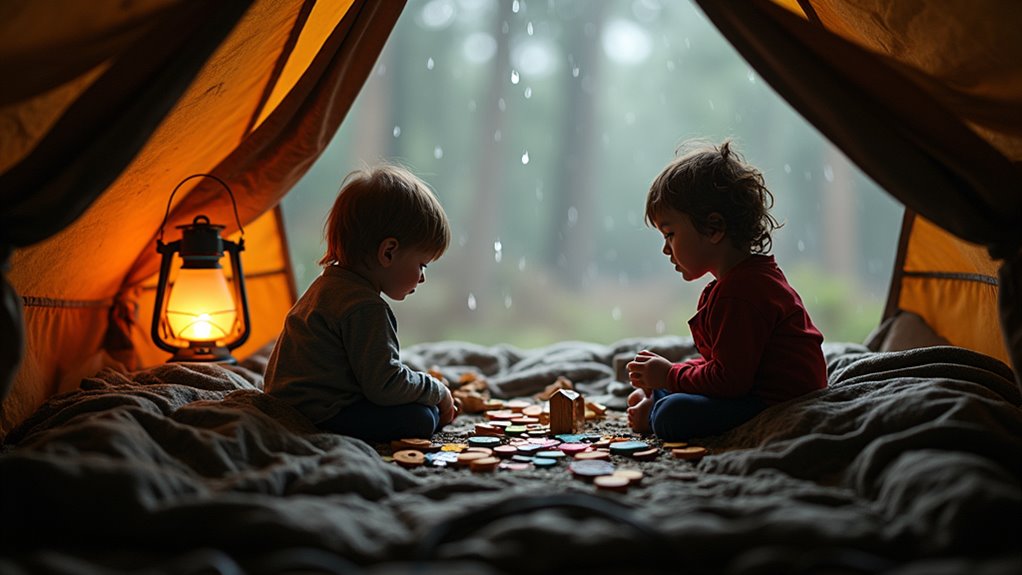
Beyond keeping bellies full, you’ll need to keep young minds engaged when weather turns sour or energy levels dip. Pack a variety of quiet activities that don’t require electricity or extensive setup.
Consider these portable entertainment options:
Store everything in a dedicated “rainy day bin” that’s easily accessible. Rotate activities throughout your trip to maintain novelty. For older children who crave more adventure, consider introducing them to canyoneering adventures that can spark their interest in outdoor exploration beyond traditional camping activities.
Setting clear expectations from the moment you arrive prevents accidents and reduces conflicts throughout your camping trip. Gather your children immediately after setting up and walk the campsite perimeter together. Point out hazards like fire pits, steep drop-offs, water sources, and nearby roads. Establish boundaries they can’t cross without adult supervision.
Create simple, memorable rules: “Stay where you can see the tent,” “Ask before touching anything,” and “No running near the fire.” Explain consequences for breaking rules, such as staying closer to parents or losing privileges.
Designate specific areas for different activities—quiet zone near tents, play area away from cooking space, and bathroom routes. Practice your emergency whistle signal so kids know when to return immediately. Clear boundaries give children freedom to explore safely. During summer months, make sure children understand the importance of staying hydrated and recognize signs of heat exhaustion to prevent dangerous overheating.

Although camping offers freedom from rigid schedules, creating a loose daily framework keeps everyone happy and prevents meltdowns. You’ll want to balance structure with spontaneity, especially when kids get cranky or bored.
Consider these timing guidelines for family-friendly camping:
If you’re planning cold weather camping with kids, make sure to learn proper techniques for keeping tents dry since moisture management becomes even more critical when children are involved.
Even with the perfect bedtime routine, sleeping in an unfamiliar environment can disrupt your child’s rest. Pack their favorite stuffed animal, blanket, or pillow from home to create familiarity in the tent. These comfort items provide emotional security and help trigger sleep associations they’re used to.
Don’t forget practical comfort gear either. Bring a small nightlight or glow stick for middle-of-the-night bathroom trips. Pack extra layers since temperatures drop at night – lightweight sleeping bags designed for children work better than adult-sized ones.
Consider bringing a small camping mat for added cushioning under their sleeping area. You can also create some of your own DIY camping gear to enhance their comfort and make the experience more personalized for your little ones.
Test all sleep gear at home first. Set up the tent in your backyard and let them sleep in their camping setup before the actual trip. This preview helps identify any comfort issues you can address beforehand.
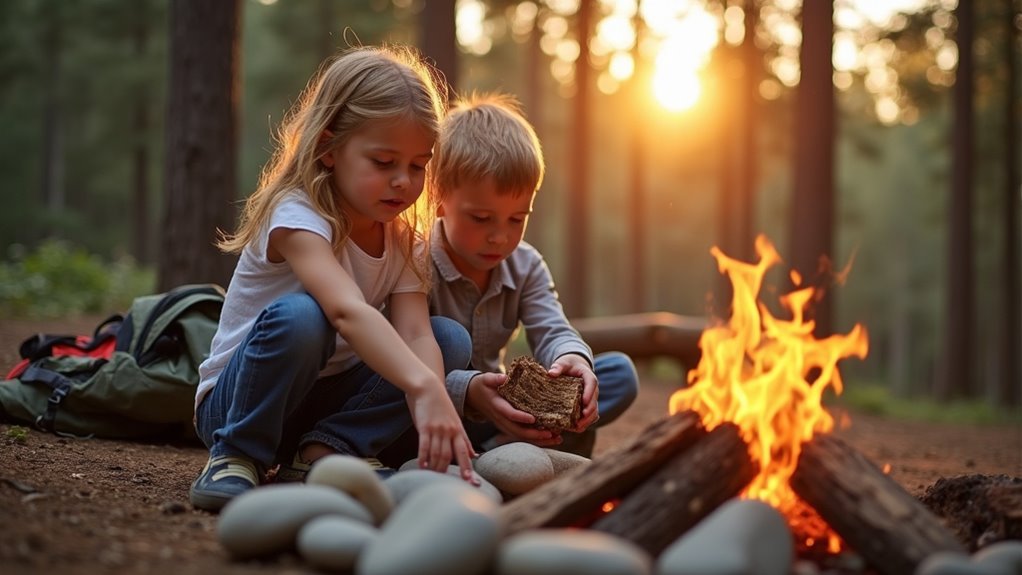
When you give children specific jobs during camping trips, they feel more invested in the experience and develop valuable outdoor skills. Start with simple tasks that match their abilities and gradually increase responsibilities as they gain confidence.
Assigning age-appropriate camping tasks builds children’s confidence while teaching essential outdoor skills and creating deeper connection to nature experiences.
Age-appropriate camping responsibilities include:
You’ll notice kids become more engaged when they’re contributing meaningfully rather than just watching adults work.
They’ll also complain less about camping challenges when they understand the effort required to maintain comfort outdoors.
Remember that assigning tasks helps create worry-free camping experiences by keeping children actively occupied and preventing them from wandering into potentially unsafe situations.
Since every child has unique interests and energy levels, you’ll create more memorable camping experiences by tailoring nature activities to what genuinely excites them.
If your child loves animals, plan wildlife observation sessions or track identification games. For budding scientists, organize rock collecting expeditions or simple nature experiments. Creative kids will enjoy nature crafts using pinecones, leaves, and stones they’ve gathered.
Consider your children’s attention spans when planning activities. Younger kids might prefer short scavenger hunts, while older ones can handle longer hiking adventures or stargazing sessions.
Don’t force activities that don’t spark interest – camping should feel like an adventure, not a chore. Watch for their natural curiosity and build activities around those moments of genuine engagement.
For families with toddlers, focus on exciting camping activities that keep their developing minds engaged while building confidence in outdoor settings.
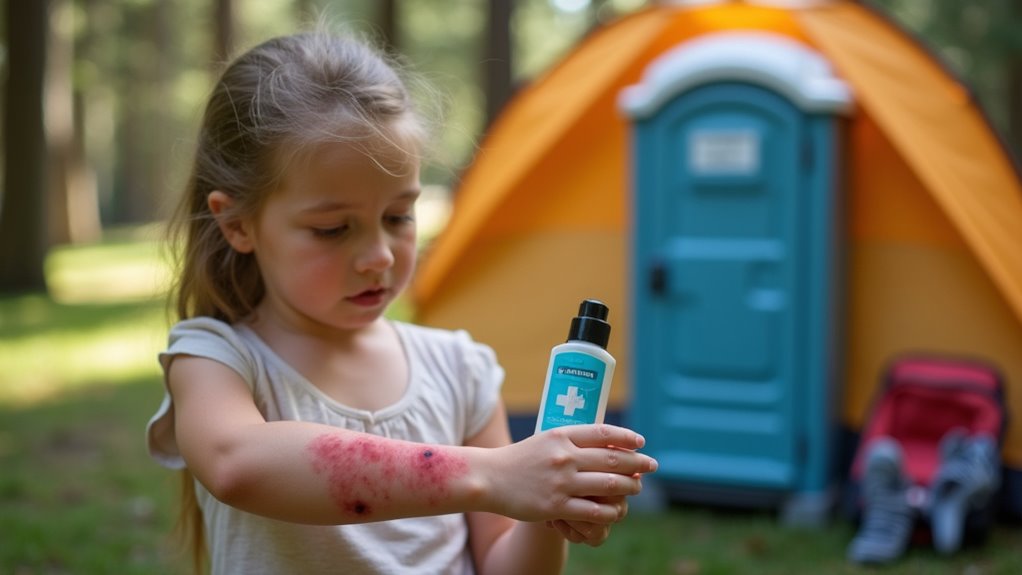
Although outdoor adventures create wonderful memories, practical challenges can quickly dampen the camping spirit if you’re not prepared. You’ll want to tackle bathroom needs and bug protection before they become major issues.
For bathroom challenges, pack a portable camping toilet or familiarize kids with camp restroom locations immediately upon arrival. Bring wet wipes, hand sanitizer, and a small flashlight for nighttime trips.
Bug bite prevention requires multiple strategies:
Before heading out, take time to assess what camping style works best for your family’s comfort level and experience with outdoor challenges. Address these basics upfront, and you’ll spend more time enjoying nature instead of managing discomfort.
Once you’ve got the basics covered, you’ll want to build your family’s camping confidence through shorter practice runs before attempting extended wilderness adventures. Start with backyard camping to let kids adjust to sleeping outdoors without venturing far from home comforts.
Build your family’s camping confidence with backyard practice runs before venturing into extended wilderness adventures with the kids.
Progress to one-night campgrounds within an hour’s drive, then gradually extend trip duration and distance.
These practice trips help you identify what gear works and what doesn’t. You’ll discover your family’s camping rhythm—how long setup takes, when kids get cranky, and which activities keep everyone engaged. Each outing builds essential skills like fire-building, tent setup, and camp cooking.
Don’t rush the process. Master car camping before trying backpacking. Let children develop outdoor confidence naturally through repeated positive experiences. Remember that even experienced campers recommend starting with essential camping tips to ensure your family adventures are both safe and enjoyable.
You’ll discover that camping with kids transforms you from a sophisticated adult into a wilderness survival expert who celebrates finding the cleanest porta-potty like you’ve struck gold. You’ll master the art of cooking gourmet s’mores while simultaneously applying bug spray, untangling sleeping bags, and negotiating bedtime stories under starlight. Sure, you’ll return home exhausted and covered in mysterious substances, but you’ll also have created memories that’ll last forever.